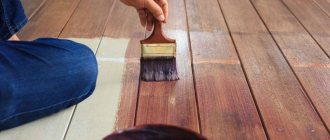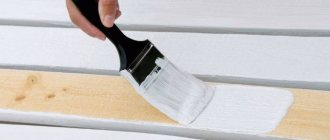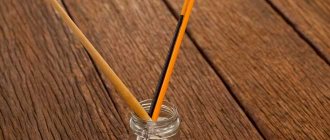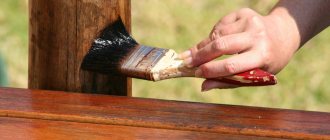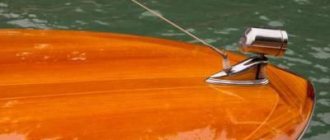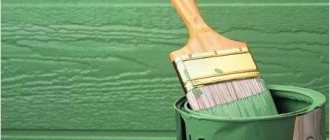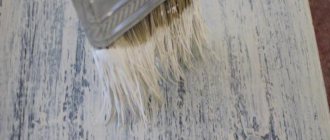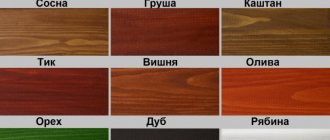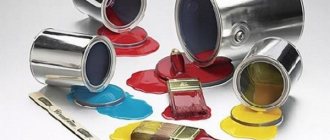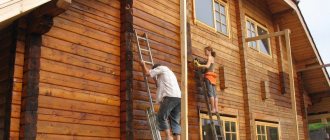Articles
All photos from the article
Currently, on the building materials market you can find simply a huge number of different substances for creating a finishing coating on wood. Moreover, they all have very different properties and colors. That is why, when planning to do the work yourself, you need to carefully study all the features of these substances and choose the most suitable ones for specific tasks.
Amateur photo of the process of painting wood using a white coating
Paint composition
Acrylic paint is classified as a water-dispersed composition based on methyl, butyl or ethyl polyacrylates. Typically the composition of such a coloring material is as follows:
- aqueous solvent - 30−40%;
- filler (cellulose, micronized marble, talc, chalk) - 30−45%;
- pigment (zinc white, titanium dioxide) - 4−20%;
- additives (alkali, alcohol, ether) - 2−4%;
- plasticizers, preservatives, antiseptics.
There are styrene-acrylic and acrylic dispersions that have the necessary technical characteristics when working with wooden surfaces:
- weather resistance;
- elasticity;
- water resistance;
- vapor permeability.
In Russian countries, acrylic or water-based paints for wood are designated with a special marking: AK is acrylic, VD is water-dispersion. The index indicates the number of paint and varnish products .
Features of choice
Usually, when choosing a material, pay attention to the whiteness of the paint . It depends on how pure the pigment was used. It is this characteristic that determines the decorative parameters of the shade. According to the level of whiteness, acrylic paints are divided into white, super-white and milky.
Covering power is responsible for paint consumption. This indicator is influenced by the composition of zinc white, titanium dioxide and the amount of water. For example: a ten-liter bucket with paint that is ideal in density and thickness should weigh 15 kilograms, no less. Penetration ability also affects the amount of material used. The protective properties that prevent peeling and cracking of the paint layer largely depend on adhesion.
When choosing products, it is also worth clarifying the anti-explosion and fire-fighting properties, the presence of toxic substances in the composition, and the period of complete drying. It is worth paying attention to the presence of antiseptics in the composition, which will protect the wood from fungus, mold, rot, and woodworms.
Covering power is divided into dry (after drying) and wet (freshly applied composition). The high content of micromarble gives good hiding power after final drying. This is ideal for working on wooden surfaces .
Performance qualities are determined by resistance to water, light, and temperature and humidity changes, which affect the long service life of the coating. The scope of application of the brand is usually indicated on the packaging. For indoor woodwork, options marked “interior” or “moisture-resistant” are suitable. Facade ones are intended for external use, although some even use them for interior work. Ceiling ones are less “receptive”; they will get dirty if applied to vertical surfaces.
Compositions with the addition of latex are the most expensive, but their quality is also high. Acrylic latex paint can withstand up to five thousand washing procedures; it has a bright palette that does not fade over time. Can be used on all surfaces, including wood.
Acrylic polymers can be called the cheapest, but they are also the most stable to ultraviolet rays. The difference with other water-based compositions is that this option tolerates low and high temperatures. The shelf life is long - up to three years. Vinyl acetate water-based paint does not have sufficient water resistance. Styrene butadiene will turn yellow over time and deteriorate from sunlight .
Why paint the inside of a wooden building?
Before painting the inside of a timber house, you should understand for what purpose such finishing should be carried out. Any type of wood, even expensive ones, loses its properties over time if additional surface protection is not applied. Indoors, a tree can be exposed to a number of factors that have a detrimental effect on it:
- Change of temperature indicators;
- Changes in humidity levels;
- Mechanical loads.
The fact that wood is a natural material is usually the reason for choosing it. Natural smells and external characteristics delight the owners. However, without a protective layer of various means, the structure will last no more than five years. As a result, the following changes will occur to the structure of the material:
- Darkening of color;
- Surface cracking;
- Various insects will begin to destroy it;
- Biological formations.
Painting the inside of your home should serve not only to improve the appearance, but also to create a barrier against external manifestations.
Without a protective layer of various products, the structure will last no more than five years.
Pros and cons of water-dispersed polyacrylate-based paints for wood
When choosing materials for interior finishing work, acrylic-based paints are the undisputed leaders. Their main advantage is their high environmental friendliness.
Other advantages also leave no chance for competitors.
- Excellent adhesion and wear resistance allow the coating to remain durable and bright, despite intensive use. It does not change color or properties after several thousand wet cleanings.
- The huge color variety of paints offered will satisfy any interior gourmet.
- Vapor permeability and resistance to ultraviolet radiation make it possible to obtain a high-quality coating when the wood dries unevenly.
- The composition penetrates deeply into the pores of the wood and creates a durable protective layer that protects the wood from damage. The addition of antiseptics reliably protects wood fibers from damage by bugs and mold.
Important! If the wood is already infested with woodworm or fungus, acrylic paint will not help. First you need to treat it with special means.
The disadvantages of acrylic paint are so relative that an experienced craftsman will not notice them at all, and a self-taught finisher only needs to remember a few tips to make working with paint a pleasure.
- When adding a coloring pigment to white paint, count on the entire area at once, since it will be more difficult to achieve the same shade the second time.
- All drops and smudges must be removed immediately, before they dry. Otherwise, you will have to buy special solvents for acrylic paint.
- Due to rapid drying, you should not leave the paint can open for a long time. Once it dries, it will become unusable. If long-term work is ahead, it is better to pour some of the paint into a small container and seal the jar.
Compared to similar products, acrylic paints are expensive. This disadvantage is fully compensated by the long service life of the finished coating.
Successful examples and options
Let's consider several good options for painting wood with different compositions.
For a terrace, you need to select paint individually, taking into account as accurately as possible all the features of a particular type of wood. There is no doubt that exposed areas of wood need to be painted darker so that street dirt and dust have less of a negative impact. However, for interior boards such a requirement is not always made, but only for design reasons.
Antique painting does not always mean using a patina effect, but it should use darker and richer tones. The picture clearly shows how they replace the original light wood background.
You can choose red, lilac, yellow or green tones - they will all look equally attractive.
You will see the technology for painting wood in the next video.
What is the difference between acrylic paint for wood and facade and interior paint?
The inclusion of technological additives in the composition allows you to obtain different properties of the coating. Depending on the nature of use, manufacturers divide acrylic paints into several categories:
- acrylic compositions for interior woodwork;
- facade materials for walls and wooden structures;
- decorative compositions for universal use;
- acrylic compositions for floor coverings.
The purpose of the paint must be indicated by the manufacturer on the packaging.
Important! Different types of paints are not interchangeable. This must be remembered when choosing materials and carrying out work.
So, for example, compositions for interior work will be destroyed under the influence of sunlight, and the facade variety will quickly wear down to wood if you cover the floors with it.
Useful recommendations for purchasing paint and painting
If you are going to paint the surface yourself, you should study the advice of professionals. Before purchasing, look at the expiration date of the paint; high-quality compositions must have a quality certificate; if it does not exist, then it is better to abandon this product.
It is advisable to paint at temperatures of +22-25 degrees. The preparatory stage should be carried out carefully; the final result depends on the quality of preparation.
Don’t forget to paint the end sections of timber and logs facing the room. It is advisable to test the color of the product before painting by applying it in an inconspicuous place; after drying, the color may change slightly.
It is advisable to paint at temperatures of +22-25 degrees.
For re-dyeing
The easiest option for choosing paint for repainting is the same as what is already on the walls (furniture, floor, ceiling).
It can be applied directly to old layers, which, of course, will speed up the process. The fact is that the coloring liquid, first applied to untreated wood, immediately penetrates deep into the material. This is one of the main reasons why it is better to use the same dyes that were used the first time when refinishing wood.
But this method is not always relevant. If you want to achieve a truly magnificent result and radically transform the situation, then first it is better to remove the old coating completely. And after this, you can apply paint to the surface, selected in accordance with all existing conditions.
terms of Use
To purchase the best paint for wooden furniture, floors, ceilings or walls, you should consider the operating conditions of a particular room.
In particular, the level of humidity, the presence of heating, and the level of fire safety at the facility are important. What type of wood the surface is made of (texture, specific species) also needs to be taken into account when choosing.
See also: Caring for the décolleté area: choosing products
When purchasing in a store, you should tell the sales consultant about all these factors, and he will tell you which odorless interior paint will be optimal in a particular case.
For example, in the case of decorative wood panels on the walls in the living room or hallway, you can choose a transparent paint coating. If you are going to paint the bathroom, then you need to choose a waterproof composition. This can be acrylic paint with additives that improve its properties.
Color selection: recommendations
You should choose based on the selected design. For a classic style, transparent compounds are applied, leaving the natural color of the material. Scandinavian style involves painting in white, pastel or light shades.
Recently, it has been popular to apply several colors to the walls. If dark colors are chosen, the room will visually look smaller, and vice versa, if light shades are chosen.
For a classic style, transparent compounds are applied, leaving the natural color of the material.
What is the secret of paint
Water-based acrylic paint is a dispersion or mechanical mixture of three components:
- Water purified from salts and organic impurities;
- Acrylate polymer - copolymer or film former;
- Emulsifiers and stabilizers;
- The adhesive base of the composition does not have a natural pure color, so a certain amount of finely ground pigment is added to the dispersion.
For your information! The starting material for producing water-based paint was ether or acrylate, a product of joint polymerization of acrylic acid and alcohol.
Pure acrylate paint was a dispersion of insoluble ether in purified water. This dispersion shows excellent mechanical properties, excellent resistance to light and water, but has one drawback - high cost and limited stability of the formed film.
Acrylate production technology allows additional molecules, so-called copolymers, to be added to the monomer, which significantly changes the properties of the material and the cost of acrylic paint. For example, the cost of pure acrylic paint for wood costs at least $7 per liter to produce.
Co-polymerization in the presence of a latex suspension makes it possible to obtain acrylic-latex paints that are several times cheaper, and have greater elasticity and excellent adhesion to wood and concrete.
In addition, latex acrylic paint should not be confused with styrene latex, obtained by copolymerizing acrylate with styrene.
Basic properties
Applying a coating (paint and varnish) to wooden surfaces is necessary to protect against destructive factors, protect against microorganisms and, of course, to update the color and give a beautiful appearance. Painted wooden surfaces become more stable and do not deteriorate from moisture.
Wood paint for interior work is available in two variations:
- water-based – based on liquid polymers;
- water-dispersion - based on solid polymers.
These two versions are similar; as they dry, moisture evaporates and the plasticizers acquire hydrophobic properties.
Wood paint intended for interior use is a special type that is characterized by safety, instant drying and uniform, easy application to the prepared surface.
With the modern composition, the surface will be ready within 2 hours after application. As a result, you get a dense layer that does not allow water and steam to pass through. At the same time, it is safe and can also be used in a children's room.
Wood coatings are divided into matte and glossy, and also into subtypes - semi-matte and semi-gloss, which are used in their own way in the interior. Manufacturers produce mixtures with special qualities, for which several components are added to the paint - fire retardants and antiseptics. Fire retardants make it possible to reduce flammability, and antiseptics protect wood surfaces from the occurrence of fungi and mold.
The main stages of preparing a wooden structure for painting
The technology for painting the outside of a wooden house includes several stages. If you want the paint to lay smoothly and beautifully, so that the coating turns out to be of high quality and durable, you must strictly adhere to the technology and consistently carry out all the preparatory work.
- First, the logs are polished with a grinder using a coarse abrasive with a grain size of P 60-80. Small cracks, nicks and other defects that remain on the wood after sawing are removed from the surface.
- Next, the surface is polished. A fine-grained nozzle P 120 or regular sandpaper is suitable for this work, with the help of which the wood is brought smooth. As a result, the surface becomes smooth and completely ready for further processing. After sanding, the wood better absorbs impregnations and paints.
- Using a construction hair dryer, the walls of the house are cleaned of wood dust formed during the sanding process.
- If there are resin stains on the wood, they are removed with a solvent.
- If there are small cracks and knots that were not removed by sanding, these places are puttied with a special wood putty.
- All metal parts (screws, nail heads) are coated with a special primer for metal.
- Next, the surface is treated with a water- or oil-based antiseptic primer to protect the wood from the adverse effects of atmospheric and biological factors. After the primer has completely dried, begin painting the house.
Which brand of wood paint is better to choose?
Today there are quite a lot of manufacturers of dyes, which may differ in quality, density and composition. Many brands did not pass the basic selection criteria, but among the best are the following manufacturers:
- Belinka - a company that has existed for more than 30 years, has been developing new compositions of paints and varnishes for various materials. One of the company’s directions is the production of safe paintwork coatings that protect the surface from negative factors.
- Alpina - the company has existed for more than 100 years, produces paints for facade work on wood, metal, and various types of enamel. The company focuses on the production and development of environmentally friendly products.
- Olsta - the company produces paints without the use of formaldehyde and other toxic substances. All the company's products have first class resistance, regardless of the material and surface quality.
- Lib eron is a French brand manufacturer of paints and varnishes. Recognized as one of the world's premium brands. The company's products are distinguished by their best characteristics.
- Tikkurila is a wide-ranging company that produces the best paints and varnishes for various wood and metal surfaces. Over the past decades, the company has been looking for new environmental compounds that have excellent durability in all weather conditions.
- Vincent - the company's products have been on the market for more than 40 years. The company produces varnishes and paints for universal use. The manufacturer focuses on the versatility of its product.
- Neomid - the company produces protective paintwork for metal, wooden surfaces, and plastic. Its main direction is odorless wood paints. The company's products have been on the market for more than 30 years.
- Dulux is one of the most premium paint brands. The company's products are used for interior and exterior decoration. Dyes are highly resistant to temperature, humidity and ultraviolet radiation.
Polyvinyl acetate coloring composition
Its base includes a mixture of oil and water (PVA), due to which the painted surfaces are stable and durable, and are easy to wash. Polyvinyl acetate composition is a quick-drying paint that is good for use in wet areas (kitchen, bathroom, toilet).
Pros:
- no unpleasant odor;
- fireproof;
- does not fade;
- has a high adhesion coefficient;
- can be tinted.
Minuses:
- low coefficient of stability to water;
- After drying, a chalky effect remains.
When drying, the moisture from the dye evaporates, as a result of which the structure hardens and becomes durable, and a semi-matte porous layer is formed. It will only take a few hours for the composition to dry completely (2-3 hours).
Latex paint
This variety is considered one of the subtypes of water-dispersed materials, where latex acts as the main inclusions. Advanced dyes use an artificial type of latex, which is dispersive particles of synthetic rubber. Such odorless paint for interior work is not toxic, and therefore is always used for any interior work.
Pros:
- mixes with other dyes;
- resistant to moisture;
- resistant to damage.
Minuses:
- not resistant to ultraviolet rays;
- Application - exclusively with a roller in 2-3 layers.
This is an excellent option for creating a durable and durable surface that is easy to clean and retains its original shade for a long period. It does not dry out, does not swell, it is rational to use it when decorating rooms with high dampness - kitchens, bathrooms.
Latex water-based emulsion is thoroughly embedded in the wood texture, creating a waterproof film that perfectly protects furniture from getting wet and makes it possible to wash it with a damp cloth.
Silicone dye
This flexible, odorless paint can be used to cover small, shallow cracks in floors and walls. The reliable silicone shell will not collapse under the influence of humidity, including in the case of direct contact with water, it resists the influence of ultraviolet radiation well, but at the same time it is highly permeable to air and water vapor.
The silicone composition, in its physical properties and technological data, has significant similarities with acrylic ones, but differs from them in the denser and brighter colors, and in addition, it is highly resistant to weather conditions and has improved performance properties.
Pros:
- UV resistant;
- has dielectric properties;
- resistant to dust, dirt, alkalis;
- long service period (20–25 years);
- universal and suitable for various surfaces.
The disadvantage is the high price.
Colorful palette: what to choose?
This video will tell you what types of paints are best for painting wooden floors.
Let's watch and remember!
When painting floors made of wood, the correct choice of paint plays a decisive role.
The modern industry of finishing and building materials offers a fairly wide range of various paint and varnish products for the design of different types of floors.
However, when choosing paint specifically for a plank floor, you should consider:
- the type of wood being painted;
- functional features of the premises being used (conditions, terms of use, humidity, etc.);
- the possibility of pre- and re-treatment of the floor covering;
- compatibility of paint/varnish with the previous flooring.
Before you buy the material you like, you need to know its individual properties and characteristics.
Today, all types of varnishes and paints are conventionally divided into transparent (substances containing them are capable of revealing the natural structure of wood) and colored opaque, containing organic solvents (acrylic, alkyds, oil).
So, what paints are the most popular for painting floor coverings?
It should be noted that only special profile painting materials are used for wooden floors.
Let's look at some of the types of paints for wooden floors.
Dispersion acrylic paint
For several years in a row it has occupied a leading position among other paint and varnish products.
The versatility of acrylic paints is proven by the versatility of their use in the treatment of external and internal surfaces.
The set of multiple advantages of these paints includes:
- vapor tightness and protection of the floor surface from atmospheric moisture;
- color fastness;
- wide color palette;
- durability (service life up to 10 years);
- ease of handling.
Oil base
This is the most common type of paint material, and just a few years ago it was extremely popular, primarily because of its low cost.
This type of product has deep, rich colors, sufficient resistance to temperature fluctuations and a uniform structure, which is what made it so popular.
However, it dries for quite a long time and over time it can radically change its appearance.
Cracks and peeling may appear on the surface.
Wear-resistant paint
Tikkurila - paint for wooden floors.
It, by definition, should be the best option for wooden floors.
However, like others, it has its advantages and disadvantages.
Its advantages:
- wear resistance;
- hygroscopicity;
- ease of application;
- resistance to peeling and fading;
- quick drying.
A prominent representative of such paints on the market of paint and varnish products today is water-dispersed acrylate paint “Tikkurila”, which is suitable exclusively for washable surfaces, having good elasticity, durability, and protective properties against mold and mildew.
Easy to apply, Tikkurila dries quickly, retaining its original appearance for a long time.
In addition, this paint option is quite economical.
The only drawback that can greatly influence the choice is the presence of a very strong specific odor when painting, which disappears only after a few days or weeks.
By the way, this product is prone to flammability.
Rubber compound
A real breakthrough in the construction industry was the appearance of this type of paint.
Despite her “youth,” she managed to gain wide popularity.
And this is completely justified.
After all, the versatility of the paint is proven by its extraordinary properties and wide range of applications.
These paints are water-based, completely environmentally friendly and safe for human health.
The main advantages of rubber paints:
- superelasticity;
- high strength;
- atmospheric stability;
- no odor;
- water resistance;
- cleanliness and environmental friendliness;
- low consumption;
- affordable price.
Today's market for painting materials offers a very wide range of products for painting wooden floor surfaces.
But given the specific purpose of the floor, it is better to make a choice in favor of natural, environmentally friendly products, such as dispersion acrylic or rubber paints.
The best paints for interior work
The rating of interior paints includes the following brands:
- Tikkurila Miranol;
- Alpina Aqua Buntlack;
- Adler Lignovit Color;
- Ace Paint Contractor Pro Interior Wall.
Next, we will dwell in more detail on the description of each of the proposed products.
Ace Paint Contractor Pro Interior Wall
A major American brand offers a new generation of paint. The innovative formula and unique composition make the product extremely easy to use and very tenacious. The paint adheres well to wooden surfaces, even those that have not been pre-treated. The composition based on acrylic material is durable and suitable for interior types of work. In addition to wood, drywall, brick and other surfaces are treated with paint. Wooden elements are leveled and take on a fresh look.
pros
- the paint applies well;
- does not peel off over time;
- multifunctional and versatile;
- hides imperfections well;
- protects wood from moisture and mold;
- does not have a pungent odor.
Minuses
- not found.
We mainly use paint in large-scale construction work, at the stage of processing and painting surfaces. We don’t mix the paint with anything, just open the can and get to work. It is applied in a thin layer, covers unevenness well and does not run down. Therefore, at the end we have completely smooth and high-quality surfaces, which, among other things, look very beautiful!
Adler Lignovit Color
An Austrian brand has appeared in our rating. It has a good reputation in Europe; it appeared in Russia relatively recently, but has found its fans here too. Acrylic paint provides long-term, high-quality protection for wooden surfaces. Thanks to the unique composition, the surfaces will be protected from fungi and mold, so the paint can be used in rooms with high levels of humidity. Suitable for various wooden elements and surfaces; as an exception, you can use paint for both interior and exterior work. As a pleasant bonus, there is a variety of rich and bright shades that you are unlikely to find in other paint collections.
pros
- suitable for any wooden elements;
- protects against fungus, mold, blue stains;
- has high elasticity;
- resistant to external influences;
- does not peel off over time;
- easy to apply;
- unlimited choice of shades and colors;
- economical consumption.
Minuses
- not found.
Ideal paint with a set of unusual shades. I know that the brand appeared here recently, so I studied reviews on European sites. They are mostly positive, users note ease of application and reliability. Therefore, we use exclusively Adler paint in our work.
Alpina Aqua Buntlack
The German company offers its own version of paint designed for treating internal surfaces. In fact, this is the world's first paint that dissolves in cold water. It is simple to use, economical in consumption and provides high-quality results. The paint is based on acrylic material, thanks to which a beautiful and uniform gloss is formed on the surface. Sold in cans of different volumes, depending on the type of work and coverage area.
pros
- there is no smell;
- has a pleasant glossy shine;
- easy to apply;
- dissolves in cold water;
- There are many rich shades to choose from;
- One coat of coating is enough.
Minuses
- not found.
If you ask me about the disadvantages of paint, I will answer only one thing - its price. This is a very expensive company, but I understand why the pricing is this way. The result of use is good and I am completely satisfied. But I would hardly take this paint if I was not sure of its quality. I recommend it to anyone who appreciates materials and results.
Tikkurila Miranol
High-quality paint from a Finnish company. Thanks to its impeccable composition, the coating is durable and uniform. The composition is suitable for the treatment of interior coatings, since it dries quickly enough and does not have a pungent unpleasant odor. The manufacturer offers many different shades, which, among other things, can be mixed with each other. It has a semi-matte effect and a very light shine.
pros
- easy to apply;
- dries quickly - takes 3-4 hours;
- no leaks;
- variety of shades;
- dense texture, one layer is enough;
- levels surfaces;
- Suitable not only for wood, but also for metal.
Minuses
- The smell is moderate, but present.
Paints and varnishes for wood
Special materials have been developed for wood that take into account its high permeability and ability to absorb and release moisture.
Impregnations
These are coatings with a complex effect, which are at the same time an antiseptic, a water repellent, and an ultraviolet barrier. At the same time, they are also used as a full-fledged wood paint for exterior or interior use, as they highlight the natural beauty of wood. Colorless impregnations with a glaze effect reveal the original texture and shade, making it brighter and more expressive. And with the help of tinted ones, you can imitate more valuable species, for example, by painting pine in the shade of golden oak or teak.
Impregnations are easy to apply, penetrate deeply and dry quickly, so processing takes a minimum of time, even when applied in two layers. The covering ability of impregnations is lower than that of paints and they are not intended to hide base defects, even minor ones. They are usually used on fresh wood when it is necessary to protect the surface quickly and with minimal investment. Impregnations are cheaper than other coatings in the line of any manufacturer and at the same time are characterized by economical consumption. But, like any other glazing, rather than covering, means, they often need updating, on average, once every 3-5 years, depending on the quality.
Brown impregnation for wood, two layers
Paints
In fact, wood paint differs from impregnations in its greater covering ability - after painting, only the surface topography is preserved. On the one hand, the unique texture of the wood appears under a thick layer of paint, on the other hand, this allows you to hide minor errors, which is often important. Wood paint, both for exterior and interior use, is indispensable when a non-trivial shade is needed. If impregnations are tinted primarily in “wood” colors of varying saturation, any paint can be ordered from a catalog. And noble gray, like Kelo pine, and variations of deep red, based on Scandinavian motifs, and inky black, more and more popular among developers, and tens of thousands of shades. And covering white paint for wood, a “classic of the genre”, without which almost no interior can do.
The properties of the paint and the durability of the coating formed depend on its type. Alkyd and acrylic compounds are mainly used for wood.
Alkyd paints - alkyd resins are used as the main binding component in these products, in combination with fillers and solvents. The solvent in alkyd paints is predominantly white spirit and similar organic substances, which is why they have a characteristic odor and are considered moderately toxic. Alkyd paints are easy to apply and dry quickly, forming an even, dense coating that is resistant to moisture, ultraviolet radiation and abrasion, but with minimal permeability. For a static base this is a minor drawback, but for wood it is critical. Alkyd film on a “breathable” wooden surface begins to crack after just two or three years, which leads to the need for repainting. And since alkyd paints have excellent adhesion to the base, serious efforts will have to be made to remove the old layer before applying a new one. However, due to their affordability and good hiding power, alkyd paints for wood are quite popular.
Acrylic paints are water-soluble dispersions or emulsions based on acrylic resins, fillers and additives (wax, marble chips, etc.). They do not contain organic solvents, due to which they do not release chemicals into the air during application; they belong to the category of environmentally friendly materials. Acrylic paints for wood are characterized by slightly lower covering ability than alkyd paints. But they penetrate into deeper layers, forming not only a durable and resistant to external influences, but also an elastic, vapor-permeable coating.
At the moment, acrylic paints are considered the best for wooden facades and other surfaces, in terms of decorativeness and durability. On average, a house coated with acrylic paint will last 10-12 years without the need for re-treatment. The only disadvantage of this type is the higher cost, but it is worth considering that wear-resistant acrylic-based wood paint will last more than two times longer than impregnation or alkyd paint.
Covering acrylic paint for wood
Oils
In their pure form, natural wood oils are practically not used for treating facades, although in terms of protective and decorative properties they are not inferior to either impregnations or paints, or even surpass them. Oils are environmentally friendly and protect wood from biological damage, moisture and ultraviolet radiation, as well as pests. Penetrating deeply into the wood, they make it more elastic, regulate humidity, protect it from drying out and extend its service life. A distinctive feature of the oil is that it improves the appearance of the wood.
Flaxseed and tung oils are widely used.
- Tung oil forms a durable, wear-resistant coating that is resistant to high temperatures. In addition to treating walls, floors, furniture, dishes and more, tung oil is recommended for treating antiques and art to ensure their long-term preservation.
- Flaxseed oil has the ability to be completely absorbed into wood, penetrating into the deepest layers. Due to its inexpensive price and availability, flaxseed oil is very popular. Flaxseed oil is suitable for treating walls, ceilings, floors and furniture.
For interior finishing, oils are used both in pure form and with the addition of wax or turpentine. Wax enhances the water-repellent effect, and turpentine has antiseptic properties.
As with acrylic paints, the coating formed on the surface repels water and dirt, allowing steam to pass through. But to maintain the original appearance, oiled surfaces need to be polished regularly (every 3-4 months). Coupled with the high cost of natural oils, this somewhat limits their scope of application. It is better to paint a wooden house with impregnation or paint, but furniture, interior walls, stairs, decking boards, flooring made of solid wood, parquet or engineered wood look gorgeous under oil.
Tung oil for wood (tinted)
Lucky
Like oils, varnishes are not intended for painting the facade of a wooden house, but are successfully used for interior decoration. Varnish forms a durable coating on wood that protects it from rotting and abrasion, and also emphasizes the beautiful structure of the wood. Unlike the previous generation of varnishes, modern ones, based on acrylic resins, polyurethane and silicone, create a durable, but elastic and vapor-permeable coating on the surface of the wood.
Varnishes are made on different bases and come in the following types.
- Acrylic.
- Polyurethane.
- Alcohol (varnish).
- Oil.
- Smolyanoy.
- Alkyd.
- Nitrolac.
- Acrylic urethane.
Whether to paint or varnish wood depends primarily on the quality of the base. Transparent varnish will add expressiveness to a beautiful texture and reliably protect, and tinted, like paint, will protect, hide, and help play with contrast if necessary.
Aqualak for wood, white (tinted)
Stripping old paintwork
It is extremely important to remove previous layers of coating, since otherwise old cracks may appear in the new paint in a short time. How exactly is such removal carried out?
See also: Rating of the best diaper creams
First you need to try to remove the paint layer with an ordinary spatula. This is labor-intensive work, but it does not require any special tools - only physical strength.
If the spatula does not work, you should use a special grinder. The surface must be processed until the wood texture appears. There is another very effective remedy - solvent treatment. Moreover, the selection of solvent is strictly based on the type of paint that needs to be removed.
Professionals use a hair dryer to remove cracked old coatings. But you need to use such a tool as carefully as possible, and in general this method is only suitable for certain species, in particular oak and beech.
Practice shows that if, after removing the old paint, you sand the wooden surface and treat it with primer and putty, the adhesion of the new coating to the wood will be much better.
Preparatory work
Before painting, remove the old coating and sand the boards.
Painting the inside of a house begins with preparing the surfaces. A wooden wall, by its nature, remains porous. In order for the paint to lay evenly on it, the following is required:
- The walls are cleaned of dust and dirt.
- Remove the old finishing layer, if any. The paint is washed off or removed using a sanding machine.
- They inspect the walls. If mold or rotten spots are found on the wood, these places are cleaned with a wire brush. Then the areas are treated with antiseptic impregnations or primers to protect the wood from fungi and mold. Boards that are more than half rotten are replaced with new ones.
- Nail heads and remnants of other fasteners are removed.
- Fallen knots, cracks, and gaps are filled with plaster mixtures with sawdust. After drying, the areas are smoothed with sandpaper.
- Before painting wooden walls inside and outside the house, the surface is impregnated with a primer. This composition improves the degree of adhesion of paint to wood.
Other measures may be necessary, for example, leveling or sanding walls, additional treatment with antiseptics or bleaches.
Should I use oil paints?
Another possible option for paint and varnish material for interior work is oil paint for wood. This coating, proven over decades, has certain advantages - a wide variety of shades, long service life, ease of use.
But still, in modern realities, applying oil paint indoors is not the best solution. It is inelastic and after some time becomes lighter, causing cracks to become visible on the surface. In addition, oil-based coatings take quite a long time to dry (about a day) - this is another obvious disadvantage. And finally, the most important thing: now in this group there are practically no products that are not toxic and do not have a strong odor.
Do-it-yourself painting of OSB boards inside the house
Before painting OSB indoors, you need to understand the intricacies of the work and the positive aspects of this solution. Painting is an option that can be implemented quickly, and you will not need to spend much money. You can also talk about the following advantages of coloring:
- A variety of types of paint and varnish products and color options, which makes it easy to choose a shade that suits the interior of the room;
- The ease of the process, you do not need to have special skills and knowledge, this saves money on the services of professionals;
- Ease of repairing damage; if damage occurs, individual areas can be repainted;
- Possibility of repainting, when the finish gets boring, the coating can always be updated by changing the color;
- Improving the protective properties of the surface; there are paints and varnishes that have moisture-proof characteristics and also create a protective layer against ultraviolet radiation;
- The surface can be cleaned; many types can be washed.
Painting OSB boards indoors is a way to hide the textured coating characteristic of the material. Although some property owners prefer to highlight the texture by only changing the shade, then varnish or stain is used.
Painting is also carried out on special types of wallpaper. Before painting the wallpaper and gluing it to OSB, the surface is prepared.
Painting OSB boards indoors is a way to hide the textured coating characteristic of the material.
Why do this, features
When deciding how to paint OSB inside the house, we must not forget about the wood component of the material. This makes it possible to use a larger number of coloring agents produced for wood.
However, this material has a number of features that people pay attention to when choosing:
- Poor indicator of surface adhesion, not all paints can adhere well to such a surface, the presence of special binding agents in the constituent elements prevents paints from penetrating deep into the enamel;
- The textured structure of the material, the surface may seem smooth, but in fact it contains roughness and irregularities. Therefore, preparatory work is mandatory; sanding is indispensable; such a texture requires increased paint consumption;
- The service life of the panels, the longer the panel is used without treatment, the more difficult it will be to paint, and the more difficult it will be for the dye to adhere to it. In this regard, it is better not to put off painting the panels inside the house for too long.
All these features require special attention when choosing the paint to be used. Therefore, the different options, their features and the properties obtained as a result will be described below.
The longer the panel is used without treatment, the more difficult painting will be.
Polyvinyl acetate paints
Polyvinyl acetate is used as the basis for the production of this type of paint. PVA paint is an emulsion created on the “oil in water” principle.
The paint components are:
- An aqueous emulsion based on polyvinyl acetate is the main component of paints and varnishes. It has a creamy appearance. Since the emulsion contains water, the freezing temperature is critical for the composition - zero degrees Celsius. An unplasticized emulsion is also produced, which can withstand 3-4 cycles of complete freezing without loss of performance.
- Pigments-dyes. These substances give the composition its color.
- Stabilizers. Additives whose task is to give paintwork materials special technical properties.
- Plasticizers. Substances responsible for the physical and mechanical properties of the mixture and the formation of a protective film.
Advantages and disadvantages of PVA paints
The qualities of polyvinyl acetate solutions may vary depending on the additives they contain. However, in general, the following advantages of these paints can be noted:
- ease of application to the surface;
- absence of toxic components and odor;
- the ability to close even the smallest cracks in the coating;
- fire safety;
- moisture resistance (this quality applies only to PVA compositions with special additives);
- elasticity, tensile strength;
- UV resistance;
- wear resistance;
- possibility of tinting;
- color stability over many years;
- vapor tightness;
- resistance to fungus and mold;
- good adhesion (adhesive qualities);
- resistance to alkaline compounds;
- low cost.
It is also worth noting that PVA paints are fast-drying (approximately 2-3 hours). The optimal air temperature level for fastest drying ranges from 17 to 23 degrees above zero. When the polyvinyl acetate composition dries, a slightly porous semi-matte film forms on the surface.
PVA solutions also have disadvantages:
- Even after complete drying, polyvinyl acetate paint can be washed off, the reason for this lies in its instability to moisture.
- Paints with a class from 0 to 10 have an effect similar to chalk - if you touch the painted surface, a mark will remain on your hand or clothing.
- Weak resistance to low temperatures - polyvinyl acetate paints cannot be applied or stored at temperatures below plus 6 degrees.
- For facade work, only water-dispersion compositions containing verstate and acrylate components are suitable.
- PVA paints are gradually becoming more expensive due to the complexity of their composition.
- When painting wooden surfaces, high-quality preparation of the wooden layer is necessary - repeated cleaning and sanding of the surface.
Most often, polyvinyl acetate compounds are used to paint those wooden surfaces that are not subject to frequent mechanical contact and are located in dry places.
Humidity is detrimental to such paints. For example, painting windows with polyvinyl acetate solutions is not recommended.
Required tools and materials
Brushes are used to paint small parts.
Before painting the log house or panels inside the house, you need to stock up on some tools and auxiliary materials:
- brushes and rollers, as well as trays for them;
- sprayer, if you decide not to paint the walls manually;
- masking tape – used to cover surfaces that should not be painted;
- rubber gloves, protective clothing, in some cases a respirator or protective mask will be required;
- wet rag, sponge or bucket.
Films are also needed to protect the floor, plumbing fixtures or furniture that cannot be removed from the room.
Specific features of alkyd paints
Some people are accustomed to using alkyd paints—varnish-based paints—to paint wood. They consist of resins, glycerin, rosin and vegetable oils. However, the composition may also contain other components, thanks to which the paint acquires certain properties. It will take about two to three days for alkyd dyes to dry completely; they cannot be called quick-drying.
Alkyd paints can last for many years, and are cheaper than water-dispersion paints. They reliably protect the wood from rotting, make it resistant to water and mechanical stress - in general, this is an acceptable material for processing wooden interior elements.
However, we must remember that almost all alkyd dyes smell strongly during the application stage. They cannot be called absolutely harmless, since an organic solvent is used in their production. However, after drying the smell disappears.
Range of paints and varnishes private label FORUMHOUSE
Which wood paint or other protective and decorative product will best cope with the task depends not only on the type, but also on the quality. The line of protective and decorative products of our brand includes all the necessary products for wood, for external and internal work with an optimal set of properties.
- Soil – FH-031, FH-037.
- Impregnation – FH-015.
- Covering paint – FH-014.
- Oil – FH-017, FH-051.
- Varnish – FH-016, FH-022, FH-023.
- Universal floor paint – FH-046.
Let's take a closer look at the properties and features of each product.
Priming
How the finish coat “lays down” and how long it lasts is influenced by the correct preparation of the base. One of the required steps before applying paint or varnish is priming the surface.
Alexander DrobotTechnical specialist of the FORUMHOUSE private label direction
Primer with antiseptic FH-037 based on aqueous alkyd, intended for treating wooden surfaces, with the exception of floor coverings, indoors and outdoors. An active antiseptic reliably protects wood from biological damage, penetrating as deeply as possible. The high dry residue guarantees reliable adhesion to both the base and the finishing layer. A permeable film is formed on the treated surface, resistant to moisture and negative temperatures. When using primer, paint (varnish) consumption is significantly reduced.
To prepare surfaces subject to increased wear (floors, stairs, doors, furniture, etc.) for painting and varnishing, a specialized primer FH-031 based on acrylic dispersion is intended. It also provides protection from moisture, maximum adhesion of the decorative layer and reduces paint or varnish consumption. Plus - it does not lift the wood pile and forms a durable film, thanks to which the treated surfaces become resistant to intense mechanical stress.
Impregnation
Alexander Drobot
Impregnation FH-015 is a glaze textured coating based on a water-acrylic dispersion with the addition of wax and an active antiseptic. Designed for long-term protection of wood from weathering and ultraviolet radiation. Suitable for use indoors and outdoors: ceilings and walls, facades, gazebos, verandas, terraces, fences and the like. Does not require the application of a finishing layer; it forms a silky-matte, vapor-permeable, elastic coating on the surface, resistant to peeling and cracking. The impregnation is available both colorless and tinted - white, pine, golden oak, oak, teak, brown, dark brown.
Universal covering paint
Universal water-based covering paint for wood of various species FH-014, intended for interior and exterior work, application can be done on both new and previously painted substrates.
- Walls and ceilings.
- Facades and platbands.
- Fences, terraces, verandas, gazebos.
The product is characterized by good hiding power and forms a semi-matte, elastic, vapor-permeable film on the surface of the wood. The coating repels moisture and dirt, is resistant to weathering, fading and wet abrasion. The painted surface can even be washed with a brush and detergents. This is especially important in rooms such as the kitchen, as well as in families with small children. The paint is tinted according to the RAL or NCS catalogs, which allows you to choose the most suitable color.
Oil
Natural tung oil FH-017 without adding any chemicals, designed for use indoors and outdoors. It is characterized by high wear resistance and reliably protects wood both from atmospheric influences and ultraviolet radiation, as well as from biological damage. At the same time, the product is absolutely safe and approved for use even on surfaces in direct contact with food (dishes, cutting boards, countertops, etc.). The scope of application is almost limitless:
- furniture, utensils and toys;
- walls and stairs;
- outdoor furniture and flooring, including on terraces and gazebos.
The product is also suitable for treating shelves, walls and floors in steam rooms, as it protects the wood from high temperatures.
Aqua oil FH-051 is an aqueous emulsion based on linseed and other vegetable oils, as well as wax, designed to protect all types of wood, significantly reducing surface cracking. Aqua oil is intended for interior work:
- ceilings;
- walls;
- stairs;
- floors;
- window;
- doors;
- furniture;
- closed terraces, etc.
It is characterized by high penetrating ability, which makes it possible to process already impregnated products and thermal wood, as well as abrasion resistance. Available both clear and tinted - brown, dark brown, grey.
Varnish
Alexander Drobot
For parquet, wooden floors and stairs inside the house, one-component polyurethane-acrylic varnish FH-023 is intended. The product forms a semi-matte, elastic, vapor-permeable, but water- and dirt-repellent coating on the surface. Resistant to increased wear and mechanical stress, intensive washing, including the addition of household chemicals and disinfectants to the water.
Universal furniture polyurethane-acrylic varnish FH-022 is used for interior work - protection of walls, ceilings, furniture, doors, windows, as well as walls, ceilings and shelves in saunas. The coating is vapor-permeable, elastic, resistant to high temperatures, wear and friction.
Aqualak FH-016 – suitable for processing:
- wooden walls;
- ceilings and doors;
- plastered, stone or ceramic interior surfaces.
A two-component water-based acrylic-silicone dispersion with the addition of wax provides reliable protection of substrates from moisture. The coating is resistant to wet abrasion.
Floor paint
Universal water-based wood floor paint with polyurethane-acrylic dispersion FH-046, can be used on both wooden and concrete bases indoors and outdoors. Suitable for areas with high traffic and heavy wear, it has the ability to repel moisture and dirt. The elastic coating is resistant to both friction and wet abrasion. Like covering paint, it can be tinted according to RAL or NCS catalogues.
Water-dispersion paints
Water-dispersion paints are characterized by the fact that they are odorless and contain no organic solvents. Water acts as a solvent, and these paints can be called environmentally friendly.
They also have other undeniable advantages:
- ease of use;
- fire resistance;
- vapor permeability;
- high adhesion (that is, the ability of paint to stay on wood for a long time without peeling or flaking);
- resistance to mechanical stress.
Depending on the additives included in the water-dispersed materials, they can be resistant to high levels of humidity. The cost of such wood paints for interior work is usually higher. If all technological requirements are met, water-dispersion paint will last up to 15 years.
Previously, water-dispersion paints were called water-based paints, but due to the increased variety of products they switched to the existing name. An emulsion, in essence, is a type of dispersion in which both the main medium and substances diluted in it are liquids.
All modern water-based paints for wood can be divided into several subtypes - acrylic, latex-based, PVA-based. They may also contain other components that add resistance to ultraviolet radiation, moisture, and heat.
Tips for choosing
When choosing paint, pay attention to what woodwork and areas you plan to cover with it.
- Interior doors, baseboards and floors are best treated with water-dispersion paint.
- If you plan to hide unevenness on wooden surfaces, we recommend using acrylic-based paint.
- Paint the walls, floors and doors in the nursery with acrylic paints. You can easily wash off the layers if necessary, and acrylic paints have an environmentally friendly composition, so they will not harm the baby’s health.
- Polyurethane paints are used in the treatment of stairs and floors because they are very durable and will not lose their brightness over time.
- Alkyd paints have a pungent odor, which is why they are more often used in outdoor applications. But alkyd paint has a very big advantage - it is capable of leveling the most difficult areas.
Sources
- https://planken.guru/vnutrennyaya-otdelka/kraski/primenenie-kraski-po-derevu-dlya-vnutrennih-rabot.html
- https://bydom.ru/news/read/akrilovaya-kraska-dlya-dereva-dlya-vnutrennih-rabot.html
- https://DrevoGid.com/zashhita/pokraska/kraska-dlya-vnutrennih-rabot.html
- https://bouw.ru/article/akrilovaya-kraska-po-derevu-dlya-vnutrennih-rabot
- https://m-strana.ru/articles/kraska-po-derevu-dlya-vnutrennikh-rabot-bez-zapakha/
- https://vyborexperta.ru/remont-i-nedvizhimost/luchshie-kraski-po-derevu/
- https://oxko.ru/luchshie-kraski-po-derevu/
- https://kraska.guru/kraski/vidy/bez-zapaxa-dlya-dereva.html
Did the article help you?
Andrey
Ask questions
Ask questions and write answers in the comments
